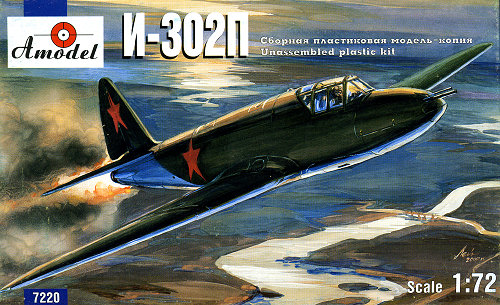
| KIT: | A-Model 1/72 I-302P rocket fighter |
| KIT #: | 7220 |
| PRICE: | $10.75 at www.greatmodels.com |
| DECALS: | One option |
| REVIEWER: | Scott Van Aken |
| NOTES: | Basically a short run kit. |

| HISTORY |
The Soviet Union was always in the need of a fast bomber interceptor. Though it did develop several aircraft, something faster was needed. That meant rocket power.
In 1940, the Rocket Propulsion Research Institute started design of a jet powered aircraft. The designer AG Kostikov was a capable but controversial engineer who felt that the best way to do things was with ramjets, the aircraft getting its initial boost from a liquid fuel rocket. It seemed like the way to do things.
The "302" was the result of this work and was to use the RD-1400 liquid fuel rocket for its initial boost. The ramjets were in-house designs and due to the expected 'thirst' of these engines, a relatively large airframe was developed. The basically wooden airframe was to be armed with two 20mm cannon.
Not unexpectedly, there were problems with both of the engines, though the airframe was ready for testing by late 1943. Also by that time it was apparent that the ramjets would never be ready and a rocket only design was developed. Gliding tests with the first and second prototype were quite successful, with the test pilot commenting that it was one of the best handling aircraft he'd ever flown. However, the writing was on the wall and by this time in the war it was pretty obvious that the rocket engine would never be fully functional. Nor would the aircraft have any sort of endurance and after one test flight in early 1944 (on skis), the aircraft crashed when a ski collapsed and the project was abandon.
| THE KIT |
 How
many of you have built A-Model kits? I see a few hands and you all know that
these kit are best treated as short run. They have thick sprues, relatively
soft white plastic, fairly good engraved detailing, and generally a low level
of flash on all the parts.
How
many of you have built A-Model kits? I see a few hands and you all know that
these kit are best treated as short run. They have thick sprues, relatively
soft white plastic, fairly good engraved detailing, and generally a low level
of flash on all the parts.
Same is true with this one. Thankfully, none of the flash is major and the kit has no areas where there are sink sections. The wings are in three pieces with a nearly full span lower wing section. The tips and ailerons/flaps are molded in the upper wing providing a nice sharp trailing edge. Cockpit consists solely of a seat that is attached to the rear bulkhead. Nothing else. But not a problem as you will see darn little through the thick canopy. In fact, the canopy has no frame lines at all so one will need to be a bit careful when it comes to masking them. Follow the box art.
Another area to watch is that of the main gear doors. The attachment holes go all the way through the doors so you'll have to fill these once the gear legs are attached. It may be a good ideal to replace the nose gun barrels with fine tubing as the kit ones are a bit large.
Markings are for one plane in Dark Green over Light Blue with eight stars. Actually, not only will four do, but you'll have to get them from another source as the reference shows them only on the fin and under wings. These should have white surrounds. There is also a speedline fronted by a small star on the fuselage that could be added as those are shown on the initial airframe. Instructions are more than adequate for a kit of this size and paint info is provided in both generic and Humbrol references.
| CONCLUSIONS |
Now I know that this isn't something that will appeal to you all. For one thing, not everyone likes prototypes and often these kits will require modeling skills that are not often used on other models. However, it is an interesting subject and that is what drew me to it. Should be fun.
| REFERENCE |
Soviet Rocket Fighters, Yefim Gordon, 2006
You can find this and other interesting kits and accessories at www.greatmodels.com
If you would like your product reviewed fairly and quickly by a site that has over 350,000 visitors a month, please contact me or see other details in the Note to Contributors.